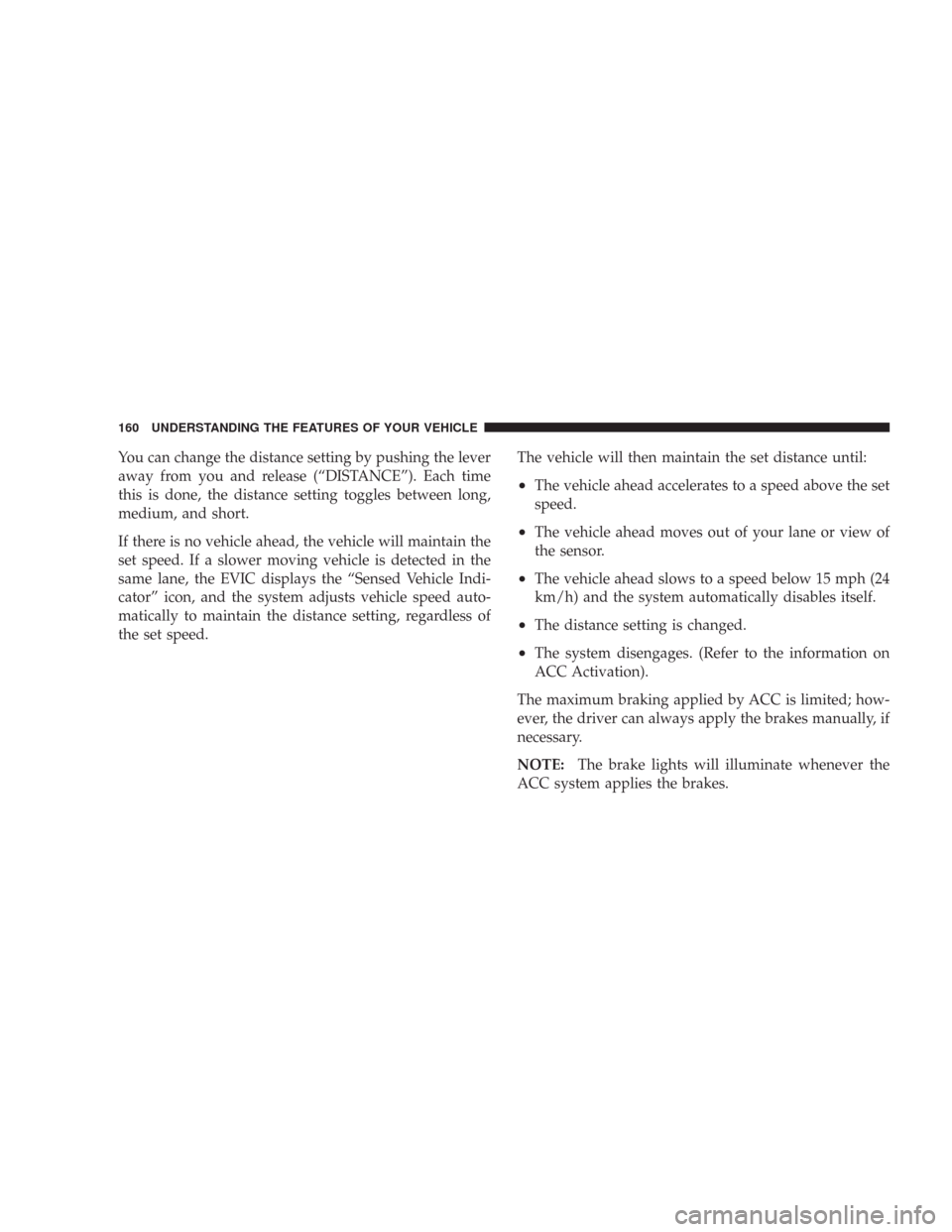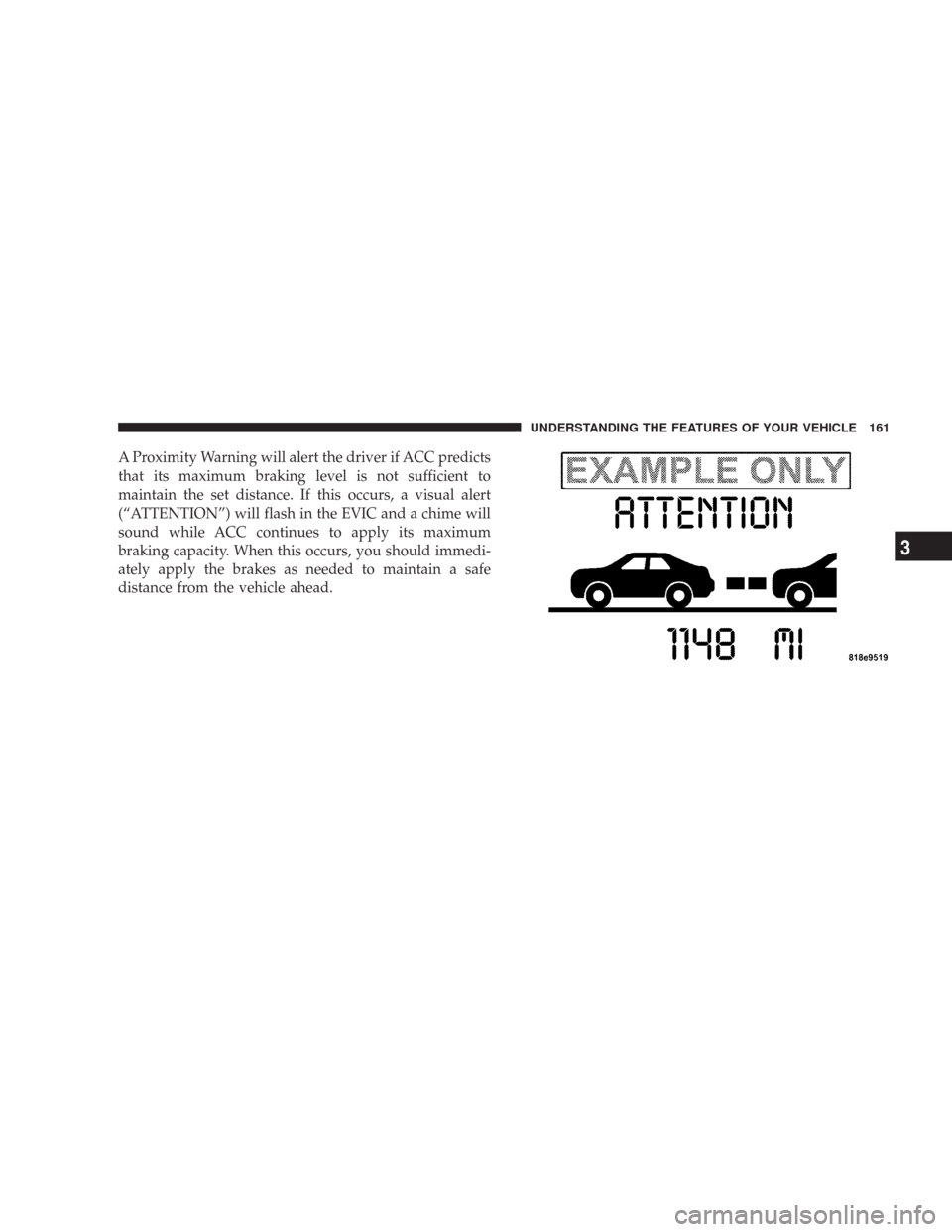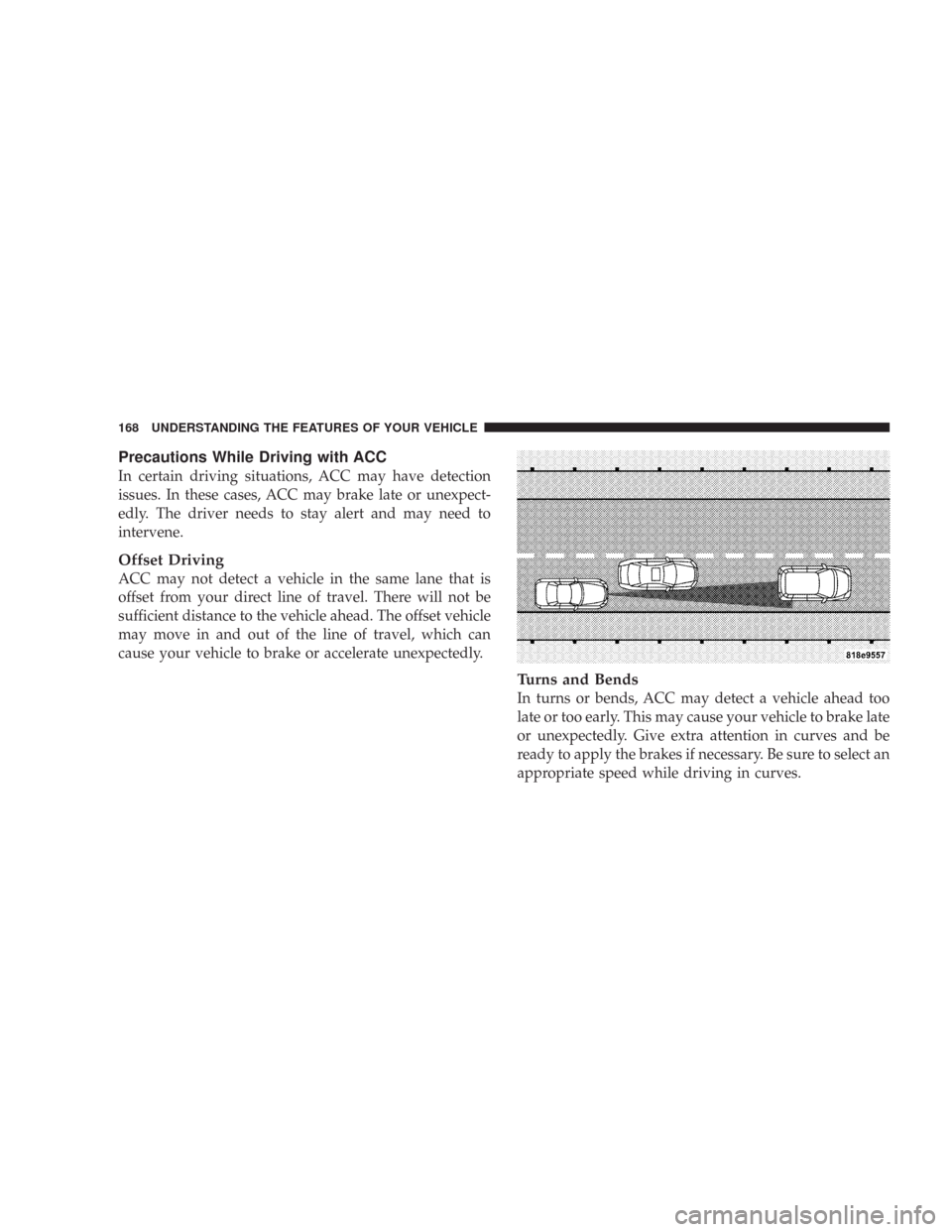CHRYSLER 300 C 2008 1.G Owners Manual
300 C 2008 1.G
CHRYSLER
CHRYSLER
https://www.carmanualsonline.info/img/25/8458/w960_8458-0.png
CHRYSLER 300 C 2008 1.G Owners Manual
Trending: key battery, maintenance schedule, ad blue, ignition, driver seat adjustment, window, emergency towing
Page 161 of 520

You can change the distance setting by pushing the lever
away from you and release (“DISTANCE”). Each time
this is done, the distance setting toggles between long,
medium, and short.
If there is no vehicle ahead, the vehicle will maintain the
set speed. If a slower moving vehicle is detected in the
same lane, the EVIC displays the “Sensed Vehicle Indi-
cator” icon, and the system adjusts vehicle speed auto-
matically to maintain the distance setting, regardless of
the set speed.The vehicle will then maintain the set distance until:
•The vehicle ahead accelerates to a speed above the set
speed.
•The vehicle ahead moves out of your lane or view of
the sensor.
•The vehicle ahead slows to a speed below 15 mph (24
km/h) and the system automatically disables itself.
•The distance setting is changed.
•The system disengages. (Refer to the information on
ACC Activation).
The maximum braking applied by ACC is limited; how-
ever, the driver can always apply the brakes manually, if
necessary.
NOTE:The brake lights will illuminate whenever the
ACC system applies the brakes.
160 UNDERSTANDING THE FEATURES OF YOUR VEHICLE
Page 162 of 520
A Proximity Warning will alert the driver if ACC predicts
that its maximum braking level is not sufficient to
maintain the set distance. If this occurs, a visual alert
(“ATTENTION”) will flash in the EVIC and a chime will
sound while ACC continues to apply its maximum
braking capacity. When this occurs, you should immedi-
ately apply the brakes as needed to maintain a safe
distance from the vehicle ahead.
UNDERSTANDING THE FEATURES OF YOUR VEHICLE 161
3
Page 163 of 520
Adaptive Cruise Control (ACC) Menu
The EVIC displays the current ACC system settings. The
EVIC is located in the upper part of the instrument
cluster between the speedometer and the tachometer. The
information it displays depends on ACC system status.
Press the Menu button (located on the steering
wheel) repeatedly until one of the following
displays in the EVIC:ACC OFF\25When ACC is deactivated, the display will read “ACC
OFF.”
Menu
Button
162 UNDERSTANDING THE FEATURES OF YOUR VEHICLE
Page 164 of 520
ACC READY
\25When ACC is activated, the display will read “ACC
READY.”ACC SET\25When ACC is set, the set speed will display.
1 — Sensed Vehicle Indicator
2 — Set Speed
3 — Your Vehicle
4 — Following Distance Setting: Three Bars = Long;
Two Bars = Medium; One Bar = Short. UNDERSTANDING THE FEATURES OF YOUR VEHICLE 163
3
Page 165 of 520
The set speed will continue to display in place of the
odometer reading when changing the EVIC display
while ACC is set.The ACC SET screen will display once again if any ACC
activity occurs, which may include any of the following:
•Set speed change
•Distance setting change
•System cancel
•Acquisition/loss of Target
•Driver override
•System off
•Proximity warning
•ACC warning
The EVIC will return to the last display selected
after 5 seconds of no ACC activity.
164 UNDERSTANDING THE FEATURES OF YOUR VEHICLE
Page 166 of 520
Display Warnings & Maintenance
ACC Blinded Warning
The ACC Blinded Warning will display when conditions
temporarily limit system performance. This most often
occurs at times of poor visibility, such as in snow, fog,
heavy rain, or when driving into direct sunlight (sunrise
or sunset). The ACC system may also become tempo-
rarily blinded due to obstructions, such as dirt or ice. In
these cases, the EVIC will display “ACC Blinded.”
UNDERSTANDING THE FEATURES OF YOUR VEHICLE 165
3
Page 167 of 520

If weather conditions are not a factor, the driver should
examine the sensor. It may require cleaning or removal of
an obstruction. The sensor is located behind the grille,
slightly offset from the center of the grille.
To keep the ACC System operating properly, it is impor-
tant to note the following maintenance items:•Always keep the sensor clean. Carefully wipe the
sensor lens with a soft cloth. Be cautious not to
damage the sensor lens.
•Do not remove any screws from the sensor or the
sensor mount. Doing so could cause an ACC system
malfunction or failure and require a sensor re-
alignment.
•If the sensor is damaged due to an accident, see your
authorized dealer for service.
•Do not attach or install any accessories near the sensor,
including transparent material or aftermarket grilles.
Doing so could cause an ACC system failure or
malfunction.
When the condition that deactivated the system is no
longer present, the system will return to the “ACC Off”
state and will resume function by simply reactivating it.
ACC Sensor Location
166 UNDERSTANDING THE FEATURES OF YOUR VEHICLE
Page 168 of 520
NOTE:Installing a vehicle front-end protector or an
aftermarket grille or modifying the grille is not recom-
mended. Doing so may block the sensor and inhibit ACC
operation.
ACC Unavailable Warning
If the system turns off, and the EVIC displays\4ACC
UNAVAILABLE,\4there may be a temporary malfunction
that limits ACC functionality. In this case, ACC will be
temporarily unavailable. If this occurs, try activating
ACC again later, following a key cycle. If the problem
persists, see your authorized dealer.
Service ACC Warning
If the system turns off, and the EVIC displays “SERVICE
ACC,” it indicates there is an internal system fault that
requires service from an authorized dealer.
UNDERSTANDING THE FEATURES OF YOUR VEHICLE 167
3
Page 169 of 520
Precautions While Driving with ACC
In certain driving situations, ACC may have detection
issues. In these cases, ACC may brake late or unexpect-
edly. The driver needs to stay alert and may need to
intervene.
Offset Driving
ACC may not detect a vehicle in the same lane that is
offset from your direct line of travel. There will not be
sufficient distance to the vehicle ahead. The offset vehicle
may move in and out of the line of travel, which can
cause your vehicle to brake or accelerate unexpectedly.
Turns and Bends
In turns or bends, ACC may detect a vehicle ahead too
late or too early. This may cause your vehicle to brake late
or unexpectedly. Give extra attention in curves and be
ready to apply the brakes if necessary. Be sure to select an
appropriate speed while driving in curves.
168 UNDERSTANDING THE FEATURES OF YOUR VEHICLE
Page 170 of 520
ACC may occasionally provide braking and/or a driver
alert that you consider unnecessary. This may be the
system’s response to signs, guardrails, and other station-
ary objects in a curve. This may also occur at the base of
dramatic hills. This is normal operation and your vehicle
does not require service.
Using ACC on Hills
When driving on hills, ACC may not detect a vehicle in
your lane. Depending on the speed, vehicle load, traffic
conditions, and the steepness of the hills, ACC perfor-
mance may be limited.
UNDERSTANDING THE FEATURES OF YOUR VEHICLE 169
3
Trending: low oil pressure, width, power steering fluid, engine oil capacity, snow chains, CD player, turn signal bulb









